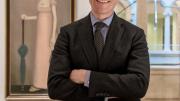When he put the two paintings together, on facing walls of a Harvard Art Museums gallery—Winslow Homer’s Pitching Quoits, showing Zouave-inspired Civil War infantrymen in their red seroual trousers, and Théodore Chassériau’s 1850 depiction of actual Arab horsemen carrying their dead from the battlefield—“It was a revelation,” says curator Ethan Lasser. Homer hadn’t yet been to France, but he admired French painters, who themselves were enamored of the Middle East and North Africa. “The vibrant conversation between these two paintings—you really need to see it in the flesh,” Lasser adds. As Stebbins curator of American art and head of the museums’ European and American art division, he tries to make such conversations visible, grouping artworks by theme and period, not country and medium: “a more contextual story.” Lasser’s parents owned a Boston art gallery, and he spent many boyhood hours roaming the city’s museums. Williams College led to a job at a New York auction house, where he was told, “You ask too many questions—go to grad school.” After a Yale Ph.D. and five years at Milwaukee’s Chipstone Foundation, specializing in furniture and decorative arts, he arrived in 2012 at Harvard, where he also teaches, co-leading classes that offer art historians hands-on experience with art-making. “You hear about ideas like ‘flow,’ or that materials always resist you,” he explains, “and here you can get a sense of what those mean in ways that are hard to express.” The museums’ artworks can be similarly elusive. “I’ll never know them fully,” he says. “I’ll be walking up the stairs one day and see something in a work that I’ve never seen before, just because it’s five o’clock in the evening in the summer.” A revelation.
Harvard Portrait: Ethan Lasser
Harvard Portrait: Ethan Lasser
A Harvard Art Museums curator on how artworks talk to one another, and to us

Ethan Lasser
Photograph by Jim Harrison
You might also like
This TikTok Artist Combines Monsters and Mental Heath
Ava Jinying Salzman’s artwork helps people process difficult feelings.
England’s First Sports Megastar
A collection of illustrations capture a boxer’s triumphant moment.
Rachel Ruysch’s Lush (Still) Life
Now on display at the Museum of Fine Arts, a Dutch painter’s art proved a treasure trove for scientists.
Most popular
Explore More From Current Issue

Open Book: A New Nuclear Age
Harvard historian Serhii Plokhy’s latest book looks at the rising danger of a new arms race.

On Weekends, These Harvard Math Professors Teach the Smaller Set
At Cambridge Math Circle, faculty and alumni share puzzles, riddles, and joy.

Introductions: Dan Cnossen
A conversation with the former Navy SEAL and gold-medal-winning Paralympic skier





